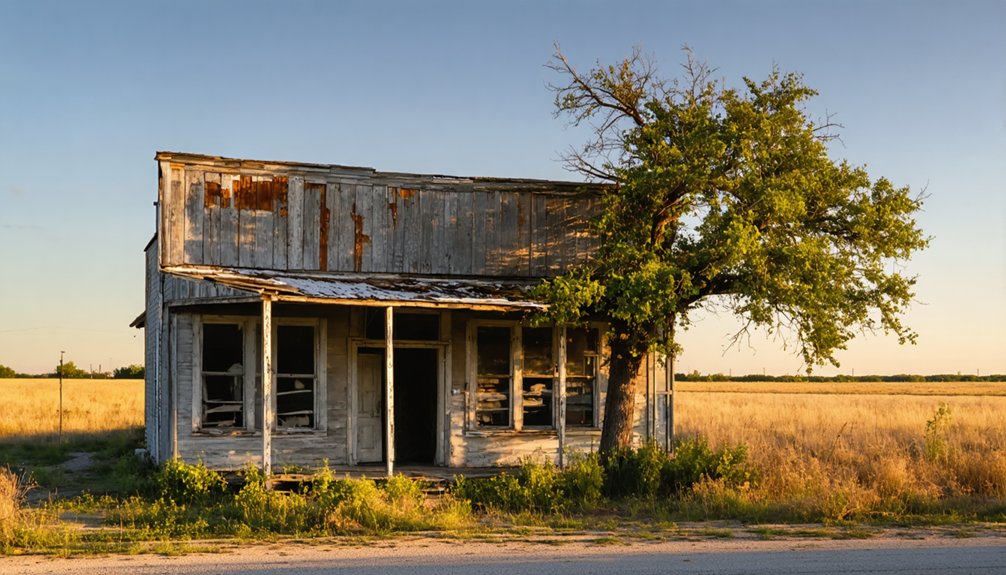You’ll find Port Sullivan‘s remnants on a limestone bluff overlooking Texas’ Brazos River in eastern Milam County. Founded in 1835 from Augustus W. Sullivan’s land grant, this once-thriving steamboat port hosted four general stores, warehouses, and the prestigious Port Sullivan Male and Female College. By 1860, its population peaked at 680, but the town’s fortune faded when railways bypassed it. Today, a 1936 Centennial marker and cemetery hold countless stories of ambition and decline.
Key Takeaways
- Port Sullivan was a thriving river town in Milam County, Texas that reached its peak population of 680 in 1860.
- The town’s prosperity relied on steamboat commerce until railroads bypassed it in the late 1860s, leading to its decline.
- Port Sullivan featured a prominent college, four general stores, warehouses, and served as an important cotton trading center.
- Today, only the Port Sullivan Cemetery and abandoned concrete locks from 1910s remain as physical evidence of the settlement.
- A 1936 Texas Centennial marker incorrectly labeled as “Fort Sullivan” marks the ghost town’s historical location.
The Birth of a Riverside Settlement
Located on a strategic limestone bluff overlooking the Brazos River in eastern Milam County, Texas, Port Sullivan emerged from a land grant awarded to Augustus W. Sullivan in December 1835.
You’ll find the settlement’s origins tied to Stephen F. Austin’s Upper Colony expansion, which brought Anglo-American settlers seeking new opportunities along the Brazos River. The location’s limestone ledge shoal made it easier for travelers to ford the river.
The settlement dynamics shifted dramatically when Reuben Anderson convinced Sullivan to subdivide his land into town lots in 1851. By 1852, the growing community had reached 200 residents and established multiple stores.
Anderson’s sons became the first lot purchasers, establishing the foundation for organized development. The location proved ideal – elevated above flood-prone agricultural lands while offering access to river transportation.
Three pivotal factors transformed Port Sullivan into a major commercial hub during the 1840s and 1850s: its strategic position on a limestone bluff, reliable steamboat access, and the growing demand for agricultural exports.
Port Sullivan emerged as a vital trading center, perfectly positioned with natural advantages and growing commercial opportunities in mid-19th century Texas.
You’ll find the river trade was essential to Port Sullivan’s economic significance, with steamboats regularly connecting the town to Galveston’s port. A crucial Lock and Dam #3 was constructed at Port Sullivan as part of efforts to improve river navigation. Established in 1835, the town quickly became a vital transportation center.
The town’s commerce flourished as merchants established:
- Four general stores and multiple warehouses for cotton and hide storage
- A circular sawmill supporting local industry and construction
- Direct trade routes to New York and other major markets
Education and Cultural Growth
During the 1850s, Port Sullivan’s cultural sophistication blossomed with the establishment of the Port Sullivan Male and Female College, a pioneering coeducational institution founded by Methodist Episcopal pastor Joseph P. Sneed.
You’ll find that this college’s educational influence extended beyond basic academics, offering classical education in literature, mathematics, and moral philosophy.
The Methodist Episcopal Church, South, played an essential role in fostering cultural cohesion through community events and moral education.
With a population of 680 by 1860, the town attracted doctors, lawyers, and families seeking quality education.
The college’s presence, supported by steamboat commerce and merchant connections to New York, transformed Port Sullivan into a regional intellectual hub.
Though the town eventually declined, its educational legacy lives on through historical markers and scholarly documentation, including the comprehensive research found in John Martin Brockman’s thesis about this once-thriving community.
Understanding Port Sullivan’s educational history helps us journey through 500 years of Texas’s vibrant cultural development.
Social Tensions and Historical Events
While Port Sullivan enjoyed prosperity through its cotton trade and educational institutions in the 1850s, social tensions simmered beneath the surface, erupting violently in the summer of 1860.
The local Vigilance Committee’s lynching of two suspected abolitionists named Boatwright revealed the deep divisions over slavery that plagued the community.
Key aspects of Port Sullivan’s social unrest included:
- Vigilante justice targeting those perceived as threats to slavery
- Political tensions between pro-slavery advocates and suspected abolitionists
- Class divisions between wealthy cotton planters and other residents
This social instability intensified during the Civil War and Reconstruction periods.
The town’s fertile soil had attracted many wealthy plantation owners who contributed to these social divisions.
As racial and political upheaval swept through the region, Port Sullivan’s community fabric began to unravel.
The town’s eventual decline reflected not just economic challenges, but the lasting impact of these unresolved social conflicts.
The absence of railroad connections ultimately sealed the town’s fate, while nearby communities with rail access continued to thrive.
The Rise and Fall of River Transportation
As steamboats began plying the Brazos River in 1835, Port Sullivan emerged as an essential river transport hub, situated near a limestone shoal that marked the head of navigation roughly 300 miles upstream from the river’s mouth.
You’d find steamboats like the Water-Moccasin battling challenging river navigation conditions, including Sullivan’s Bluff’s notorious limestone ledge that created a mile-long obstruction downstream.
Despite these transportation challenges, the town thrived as flatboats shipped cotton in the 1850s, and steamboat traffic spurred growth in warehousing and mercantile businesses. A fleet of seven flatboats transported cotton down the Brazos in April 1854.
By 1860, Port Sullivan had grown into a bustling town of 680 residents as river commerce flourished.
However, you couldn’t escape the impact of progress – when railways arrived in the late 1860s, they offered faster, year-round shipping that steamboats couldn’t match.
This shift ultimately contributed to Port Sullivan’s decline as trade moved away from the river.
Abandoned Dreams and Lost Opportunities
The ambitious vision for Port Sullivan began in 1835 when Augustus W. Sullivan established a trading post overlooking the Brazos River.
You can still sense the economic aspirations in the remnants of this once-promising settlement, where dreams of becoming a major river port collided with harsh realities.
The community struggles became evident through:
A settlement’s path to prosperity can crumble when faced with navigational hazards, failed engineering projects, and missed economic connections.
- Failed attempts to navigate treacherous limestone shoals
- Unsuccessful U.S. Army Corps of Engineers’ lock construction projects
- Critical miss of railroad connections that transformed nearby towns
What you’ll find today are silent reminders to abandoned dreams: concrete locks weathering along the Brazos, empty spaces where warehouses once stood, and forgotten paths where wagons once rolled.
The town’s population peaked at 680 in 1860, but without reliable transportation infrastructure, Port Sullivan’s hopes of commercial prosperity gradually faded into Texas history.
Legacy in Stone and Memory

Standing sentinel along the Brazos River, Port Sullivan‘s physical remnants tell a compelling story through stone and memory.
You’ll find abandoned concrete locks from the 1910s, silent witnesses to ambitious dreams of river navigation, while the 1936 Texas Centennial marker stands firm despite erroneously naming the site “Fort Sullivan.”
The Port Sullivan Cemetery offers tangible connections to the town’s past residents.
Historical preservation faces ongoing challenges, as vandals have damaged several markers, leaving bullet holes and missing medallions.
Yet community engagement remains strong, with local historical commissions working to maintain these stone legacies.
Through oral histories and online documentation, you can trace Port Sullivan’s journey from a hopeful river port to its eventual decline, keeping alive the memory of this once-thriving marketplace and educational center.
Frequently Asked Questions
What Happened to the Original Residents of Port Sullivan After Its Decline?
You’ll find that residents scattered to nearby settlements, seeking economic opportunities along railroads, while others moved south. Their relocation stories and ghost tales live on through historical markers.
Are There Any Surviving Photographs of Port Sullivan During Its Peak?
You won’t find any verified photographs from Port Sullivan’s peak period in public photographic archives or historical preservation collections. Research indicates surviving images from the town’s 1850-1860s heyday haven’t been documented.
What Native American Tribes Originally Inhabited the Port Sullivan Area?
While powerful Comanches and Kiowas passed through to hunt buffalo, you’ll find the area’s cultural heritage was shaped by the Tawakoni, Tonkawa, and Waco tribes who made it their permanent home.
How Deep Was the Brazos River Near Port Sullivan in the 1800S?
You’ll find the Brazos River depth near Port Sullivan fluctuated between 3-6 feet during normal conditions, though it varied with seasonal changes and limestone shoals. Historical river changes affected navigation patterns.
Were There Any Notable Archaeological Findings at the Port Sullivan Site?
Among 1900s lock ruins, you’ll find remains of the U.S. Army Corps’ navigation structures, historic cemetery artifacts, and plantation-era items revealing life stories of both enslaved people and settlers at Port Sullivan.
References
- https://en.wikipedia.org/wiki/Port_Sullivan
- https://www.texasalmanac.com/places/port-sullivan
- https://kids.kiddle.co/Port_Sullivan
- http://www.milamcountyhistoricalcommission.org/info_sought_158.php
- https://www.ghosttowns.com/states/tx/portsullivan.html
- http://www.countygenweb.com/txrobertson/port_sullivan.htm
- https://www.tshaonline.org/handbook/entries/port-sullivan-tx
- https://www.forttumbleweed.net/portsullivan.html
- http://www.countygenweb.com/txrobertson/books/PortSullivanI.htm
- https://brucewiland.com/brazos/navigating_the_Brazos.html



